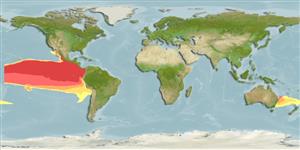Common names from other countries
Environment: milieu / climate zone / depth range / distribution range
Ecologia
marinhas; oceanódromo (Ref. 51243); intervalo de profundidade ? - 50 m (Ref. 37955). Tropical; 30°N -
Eastern Central Pacific: western coast of Baja California, Mexico to Peru (Ref. 11482).
Tamanho / Peso / Idade
Maturity: Lm ? range ? - ? cm
Max length : 37.0 cm TL macho/indeterminado; (Ref. 55763); common length : 20.0 cm TL macho/indeterminado; (Ref. 55763)
Descrição suscinta
Chaves de identificação | Morfologia | Morfometria
Body elongate, moderately deep, and compressed; snout slightly pointed; adipose eyelid poorly developed; lower branch of the first gill arch with 28 to 30 gill rakers; chest entirely covered by scales; lateral line arched anteriorly, with 46 to 53 strong scutes in the straight part; back gray blue; belly silvery with green-gold highlights; 8 to 9 incomplete, dark, vertical bars along the flanks; edge of operculum with a very conspicuous black stain (Ref. 55763).
Adults inhabit coastal and oceanic waters (Ref. 9283). They feed on small fishes, crustaceans and other benthic invertebrates (Ref. 37955). Marketed fresh and salted or dried (Ref. 9283).
Ciclo de vida ou comportamento de acasalamento
Maturities | Reprodução | Spawnings | Egg(s) | Fecundities | Larvas
Allen, G.R. and D.R. Robertson, 1994. Fishes of the tropical eastern Pacific. University of Hawaii Press, Honolulu. 332 p. (Ref. 11482)
Status na Lista Vermelha da UICN (Ref. 130435)
CITES (Ref. 128078)
Not Evaluated
Ameaça para os humanos
Harmless
Uso pelos humanos
Pescarias: espécies comerciais; peixe esportivo: sim
Ferramentas
Relatórios especiais
Baixar XML
Fontes da internet
Estimates based on models
Preferred temperature (Ref.
115969): 21.8 - 28.5, mean 26.3 (based on 52 cells).
Índice de diversidade filogenética (Ref.
82804): PD
50 = 0.5000 [Uniqueness, from 0.5 = low to 2.0 = high].
Bayesian length-weight: a=0.01738 (0.00796 - 0.03794), b=2.94 (2.77 - 3.11), in cm Total Length, based on LWR estimates for this Genus-body shape (Ref.
93245).
Nível Trófico (Ref.
69278): 3.7 ±0.54 se; based on food items.
Resiliência (Ref.
120179): Elevada, tempo mínimo de duplicação da população menor que 15 meses (Preliminary K or Fecundity.).
Fishing Vulnerability (Ref.
59153): Low to moderate vulnerability (27 of 100).
